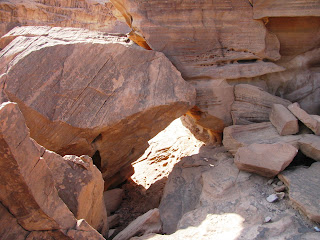This morning I woke up at first light and walked to the wetlands. There are lots of kitties here, and they have mites on their noses, and underfed, unhealthy and prolific. If my friend Mary were here, she would commission one of those big cargo planes, load up all the kitties, and take them back to the U.S. for veterinary care and love.
The gate to the wetland reserve was locked, so I walked out into the desert behind the reserve to get a sense of how big it was, and what it looks like from behind. This is a virid, vital postage stamp wetland where once it stretched for miles and miles. Its like the pulse on your neck; one spot on the whole body, and the pulse for the whole system.
The four big sacred springs are gone. Water is pumped into the reserve, with the people of Azraq first. They only get water three days per week, and usually the water doesn't arrive on time. People wait to take showers, wash clothes, wash their hair. The reserve comes last, but today the water is flowing out of the pipes, and the wetland is a virid green oasis.There are many layers and colors of vegetation; the tamarisk trees, Phragmites taller then the trees, and the reeds and cattails in rounded clumps around the water. As I walk to the edge of the reserve, the piles of sediment dredged from the bottom on the pools is stacked with roots/ rhizomes of Phragmites and Typha. Inside the pools agtails dip and bob, herons and egrets reflect and ripple in the water. White egrets perch in the Tamarisk, and a stilt cries out and flies across the pool. So small, so fragile, so precious.
Hazem, the refuge manager, has gone out of his way to take Clara and I to meet people and to teach us all he can about the Azraq aquifer, the fight for the wetlands, and the needs of the Azraq people. Azraq means blue. The remaining water, the remaining wetland, is a treasure - like the blue diamond in my wedding ring. Surrounded by gold, the gold of the Chechen, Druze and Bedouin communities. Over this past week, we have been invited to homes of leaders of each of these community groups, and people have been so generous with their time and knowledge. We sit in their guest rooms, drink coffee, drink sweet tea, have some fruit. We spend hours talking, listening, and laughing, making new friends. Something that never happens in my academic environment - people never, ever have the time to sit and visit, to talk and listen to each other. Too busy to listen, to share.
Today we went out to a local farm. Olives, pomegranates in bloom, date trees with a spray of new dates, apricots. He also has a big house for doves to come and go, pipe shelters for turkeys,and a hutch for bunnies. We sat and talked outside, the cool breeze under the trees a perfect temperature. A small dog, underfed and unhealthy, scurried by while we sat talking. It hurried out of site, not to appear again. This farm, like the wetland, also a treasure and an oasis in the midst of this drying, desertifying landscape. No water. Amman has the water, water pirates have the water, and so little remains for the people.
As I write this, the refugee camp continues to be build for 450,000 to 600,000 people. They will have two wells for all those people, and plan to truck out the waste. International humanitarian organizations are providing funds for relief, and soon the refugees will be coming to this hot tent city in the middle of a very barren and bleak landscape . A military base is close to the future refugee camp, and that is where the American and Jordanian miliray are exercising "fierce lion" where they are doing miliatary exercises here on the syrian border.
Many of the first refugees from Syria, as well as from Iraq, are or were rich. They buy property and drive up the price of housing and services. While there will be some jobs in the refugee camp, some people will be able to bribe there way out and move to Azraq and will need jobs. The communities of Azraq fear they will take local jobs, which are few and far between. The unemployment in this area is extremely high after the salt cooperative closed. Unrest on the border has affected tourism and eco-tourism to the area. Water only is delivered three days per week, and limited opportunitiespccur in this rural area for making a livelihood. People tell me they have to buy everything, they can't have their animals graze, and fish and hunt and create a subsistence livelihood like they did before.
Azraq is a wonderful community. We've been treated with such hospitality, and met such interesting people. This wetland, these birds and wildlife, these farms and agriculture sustain the community. Above all, the community needs water. I've been touched deeply, been privileged to learn a great deal from these generous people. I don't think I'll be the same leaving here as when I arrived.
These war planes fly low and fast and loud over the town. The American and Jordanian pilots play boys with their toys, showing off their prowess. This military precense is not who I want to be as an American, this is not how I want to be perceived by people in this country that is one of our few friends in the region . Salam aleikum, peace be to you, peace be to the people of this town Azraq, and peace be to all the animals and plants and living things trying to survive without water.

































